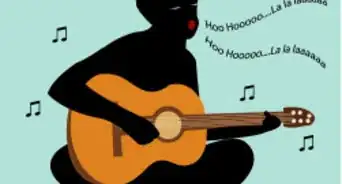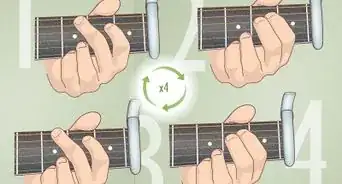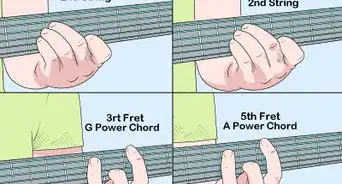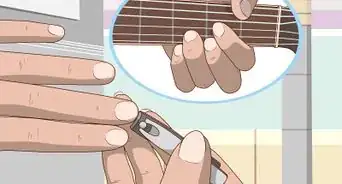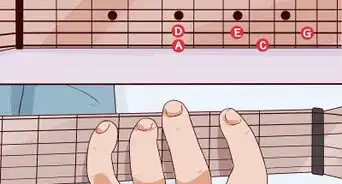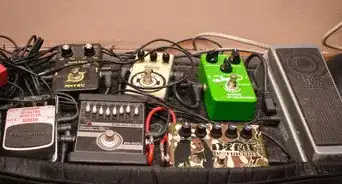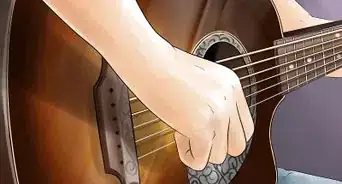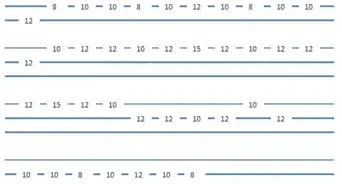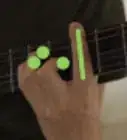This article was co-authored by Nicolas Adams and by wikiHow staff writer, Jennifer Mueller, JD. Nicolas Adams is a 5th generation musician of Serbian Gypsy descent and the lead guitarist of the band Gypsy Tribe. Based in the San Francisco Bay Area, Nicolas specializes in Rumba Flamenco and Gypsy jazz and playing the guitar, Bouzouki, Balalaika, and piano.
This article has been viewed 138,588 times.
When you sweep pick, you sweep or rake your pick across the strings, producing a quick flurry of notes. Essentially, you're playing several notes on adjacent strings while moving your pick in the same direction. This advanced guitar technique is perhaps most commonly associated with rock and heavy metal "shredding," but it is used in many different musical genres, even country. To learn how to sweep pick, you first must ensure your hands are placed correctly. Start slow and practice daily to develop your technique and improve your skills.[1]
Steps
Mastering the Fundamentals
-
1Use the right gear. Sweep picking sounds best with a Strat-style guitar and a modern tube amp. You also want to use a pick that's between 1 and 2 millimeters thick and has a more rounded tip.[2]
- Set the gain on your amp to a moderate amount. You want each note to have uniform volume and sustain, but if you set the gain too high, it will be virtually impossible to mute the other strings.
- Make sure your guitar strings are all at the same intonation. Using your neck pickup will help reduce a lot of noise.
-
2Start with your strumming hand. One of the easiest ways to learn how to sweep pick is to isolate each hand and get the technique down correctly. Once both of your hands know what to do, all you have to do is get them working together.
- When you sweep pick, you essentially let the pick fall from string to string in one smooth, continuous stroke.
- Imagine that your hand is being pulled by a string tied to your wrist. Release the tension in your hands so you're holding the pick loosely.
- Keep the pick moving at whatever tempo you've chosen – don't stop to pick each individual string. If you break the momentum of your picking, you'll have a hard time being able to sweep pick clean and fast.[3]
Advertisement -
3Try slow-strumming chords. One method that can get your strumming hand used to gliding or sweeping over the strings for sweep picking is to take chords you know and like, and arpeggiate them to articulate each note.[4]
- Doing this also will get you used to how slowly your hand actually needs to move, even if the notes are coming relatively quickly.
- Keep in mind that what you're doing right now is not sweep picking, because the strings continue to resonate as you play. To sweep pick, you must learn how to mute all the other strings except the one you're fretting.
-
4Learn to roll your fretting fingers. Rolling your fingers to mute a string immediately after playing it is what gives a sweep picked arpeggio its distinct sound. Your barring finger should be extended and slightly arched so you can rock it back and forth.[5]
- Essentially, the first knuckle of your finger is going to collapse to mute the string immediately after playing it.
- If you're just starting to learn to sweep pick, your fingers may have trouble with this unfamiliar movement. Do exercises to limber up your fingers and improve their agility.
- One exercise you can do is to simply extend all your knuckles on both hands so that your fingers are straight. Then gently press your opposing fingertips together. Hold for about 5 seconds, then release. You can do this exercise as many times as you want, just make sure not to press too hard.
-
5Prioritize efficiency over speed. If you watch master sweep pickers play, you'll notice that their hands don't actually move all that much, or move all that fast – relative to the barrage of notes they're playing.[6]
- Faster playing comes from making more efficient movements, not from moving your hands faster.
- You can do finger strengthening exercises to increase the power and efficiency of your fingers and hands. This well help you sweep pick at a faster tempo.
-
6Synchronize your hands. To sweep cleanly, your pick and your fretting fingers must make contact with the string you want to play at exactly the same time. This can take practice to do with precision.[7]
- If you've mastered the technique that you should use with each hand, it should be easier to coordinate them than if you're struggling to learn those and trying to coordinate at the same time.
- Go slowly at first, focusing on your two hands acting in unison. Keep in mind it is possible that your more dominant hand is going to be faster than the other, so keep your practices at a slow tempo and gradually build up to faster speeds only when your hands are naturally synchronized.
- Synchronizing your hands is one of the most difficult parts about sweep picking, and it's one that can only be achieved with practice. There aren't any special exercises or drills you can do that will improve this for you.
Developing Your Technique
-
1Use a metronome. As you're practicing sweep picking and working on your technique, a metronome can help you maintain the same tempo and keep your hands synchronized.[8]
- Start with your metronome set to eighth notes. It may seem slow to you at first, but stick with this speed until you have progressed to doing six-string arpeggios.
- Once you've mastered six-string arpeggios with eight notes, you can gradually move up to sixteenth notes.
-
2Mute the other strings. You want to ensure that only one string is sounding at a time. All other strings should be muted with your other fingers as you fret the string you want to play.[9]
- When you play, you should only be fretting one string at a time. Your remaining fingers have the work of muting all the other strings. If the other strings are sounding, you'll just sound like you're strumming a chord – there won't be any separation between the notes characteristic of a sweep pick.
- Keep in mind that the practice of muting the other strings may be one of the more difficult parts of sweep picking to master. Be patient and take your time as you practice.
- When you're just starting, it might help to fold a washcloth and secure it to the frets with a large rubber band. This will mute the strings for you and prevent unwanted noise.
-
3Identify parts that are giving you problems. If you're finding a particular area of an arpeggio difficult, it may be because your fingers can't move efficiently to play those notes. Work on the notes that give you problems by themselves.[10]
- You can create your own two- or three-note drill out of the portion of an arpeggio that you find difficult. Drill it, first with each hand by itself, and then with both hands together, until you can play it as cleanly as you play the rest of the arpeggio.
-
4Work with a guitar teacher. Once you've got the fundamentals of sweep picking down, you may want to go in for a session or two with a guitar teacher who can watch you play and show you where your technique is sloppy.[11]
- If you have a friend who is skilled at sweep picking, they also may be able to help you figure out how you can improve.
- You might also watch videos online. If you can videotape yourself, you can compare your own sweep picking to the hands of someone on a video who has mastered the technique. This is another way to identify areas where you can improve.
- Break down the job of each individual finger on your fretting hand, so you can figure out which finger isn't doing exactly what it's supposed to be doing and work on that movement.
Improving Your Skills
-
1Practice every day. Sweep picking can take several months to do cleanly and correctly. However, you can improve little by little if you take just a few minutes each day to work on your technique.[12]
- In addition to practicing your sweep picking mechanics, you also want to practice scales, so your fingers will become accustomed to moving through basic patterns.
- You also might practice your hammer-ons and pull-offs, which can improve the speed and efficiency with which you roll your fretting finger when sweep picking.[13]
-
2Spend time at each practice isolating your hands. Once you're drilling different arpeggios, practice by spending about five minutes fretting the arpeggio without strumming. Then spend another five minutes picking the arpeggio without fretting.[14]
- Do this first with two-string sweeps. Once you've mastered the mechanics of two-string sweeps, isolate your hands again to learn the movements with three-string sweeps, and so on.
- Keep in mind that if each hand hasn't mastered what it's supposed to do, it will be much more difficult to have your hands working in synchronization.
-
3Start with two-string sweeps. When you're just learning to sweep pick, two-string sweeps allow you to work on the mechanics and synchronize your hands, because neither of your hands has to move very far or very much.[15]
- Two-string sweeps also can help you with muting, because you'll only have to roll between two strings, essentially switching back and forth between them.
- You also can do basic sweeps based on arpeggiated chords, which you can build yourself using chords you already know.
-
4Work your way up to six-string sweeps. When you've mastered two-string sweeps, move on to three-string sweeps, then four-string sweeps, and so on. Stay at the same tempo as you progress and focus on keeping your hands synchronized.[16]
- When you start working into longer arpeggios, break them down into four-bar sequences and practice the shorter parts. Once you've mastered each sequence, you can start putting them together.
Expert Q&A
-
QuestionHow do you hold a pick when sweeping?
 Nicolas AdamsNicolas Adams is a 5th generation musician of Serbian Gypsy descent and the lead guitarist of the band Gypsy Tribe. Based in the San Francisco Bay Area, Nicolas specializes in Rumba Flamenco and Gypsy jazz and playing the guitar, Bouzouki, Balalaika, and piano.
Nicolas AdamsNicolas Adams is a 5th generation musician of Serbian Gypsy descent and the lead guitarist of the band Gypsy Tribe. Based in the San Francisco Bay Area, Nicolas specializes in Rumba Flamenco and Gypsy jazz and playing the guitar, Bouzouki, Balalaika, and piano.
Professional Guitarist If you want to sweep pick, you'll use your strumming hand—typically your right hand—to combine a single down stroke and a single up stroke across the strings. With your other hand, each time you play a note, press down on the string to mute it.
If you want to sweep pick, you'll use your strumming hand—typically your right hand—to combine a single down stroke and a single up stroke across the strings. With your other hand, each time you play a note, press down on the string to mute it.
References
- ↑ http://www.cyberfret.com/guitar-techniques/sweep-picking-basics/
- ↑ http://www.guitarworld.com/big-strokes-beginners-guide-sweeping
- ↑ https://tomhess.net/WhyFastSweepPickingIsEasierThanYouThink.aspx
- ↑ https://www.ultimate-guitar.com/lessons/guitar_techniques/guide_to_sweep_picking.html
- ↑ https://tomhess.net/SweepPickingRolling.aspx
- ↑ https://tomhess.net/WhyFastSweepPickingIsEasierThanYouThink.aspx
- ↑ http://www.guitarworld.com/big-strokes-beginners-guide-sweeping
- ↑ http://www.guitarworld.com/big-strokes-beginners-guide-sweeping
- ↑ http://www.guitarworld.com/big-strokes-beginners-guide-sweeping
- ↑ https://tomhess.net/WhyFastSweepPickingIsEasierThanYouThink.aspx
- ↑ https://tomhess.net/WhyFastSweepPickingIsEasierThanYouThink.aspx
- ↑ http://www.guitarworld.com/big-strokes-beginners-guide-sweeping
- ↑ http://www.cyberfret.com/guitar-techniques/sweep-picking-basics/
- ↑ https://tomhess.net/WhyFastSweepPickingIsEasierThanYouThink.aspx
- ↑ http://www.guitarworld.com/big-strokes-beginners-guide-sweeping
- ↑ http://www.guitarworld.com/big-strokes-beginners-guide-sweeping
About This Article
To sweep pick, use a Strat-style guitar, a modern tube amp, and a rounded pick that's 1-2 millimeters thick to create the best sound. Next, set the gain on your amp to a moderate amount so that each note is uniform in volume and sustain. Then, strum the strings using chords that you already know, letting the pick fall from string to string in one smooth, continuous stroke. Remember that your pick and fretting fingers must make contact with the string you want to play at exactly the same time to sweep cleanly! For tips on using a metronome to get the right tempo and synchronize your hands, read on!
